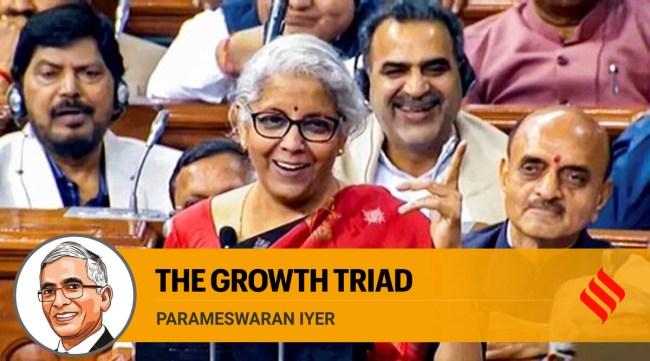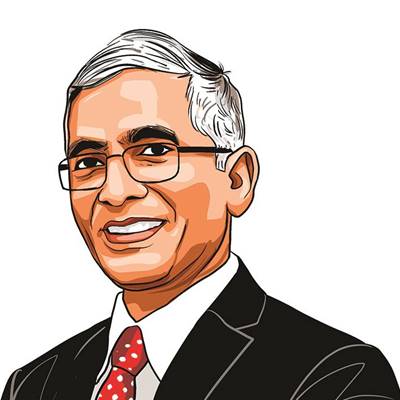Opinion CEO NITI Aayog Param Iyer on Budget 2023-24: An infrastructure push for the people
Focus on physical, digital and social infrastructure in Union budget places people at the heart of policy.
 Finance Minister Nirmala Sitharaman presents the Union Budget 2024 in Parliament on February 1. (Photo via PTI)
Finance Minister Nirmala Sitharaman presents the Union Budget 2024 in Parliament on February 1. (Photo via PTI) Infrastructure is universally acknowledged as a key driver of growth. Traditionally, though, infrastructure is associated with physical assets, typically roads, ports, power transmission lines, etc. However, since 2014, India’s development story has been closely linked with a strong focus on not just physical, but also social and digital infrastructure. Budget 2023 gives a powerful thrust to these three dimensions of infrastructure development which, put together, accelerate inclusive growth.
The Government of India’s capital expenditure as a percentage of GDP increased from 1.7 per cent in 2014 to nearly 2.9 per cent in 2022-23. In Budget 2023-24, Rs 10 lakh crore (3.3 per cent of the GDP), an increase of three times from 2019, was allocated for infrastructure. The Ministry of Railways received its highest-ever allocation of Rs 2.4 lakh crore, approximately nine times the allocation in 2013-14. The Ministry of Road Transport and Highways saw a 36 per cent increase in its budget to about Rs 2.7 lakh crore. These targeted investments will not only create vital physical infrastructure and improve connectivity that will accelerate the movement of passengers and freight, but also create jobs, spur private investments, and provide a cushion against global headwinds.
The direct capital investment by the Centre has been further supplemented by a one-year extension of the 50-year interest-free loan to state governments to encourage infrastructure investment and incentivise complementary policy actions, with a significantly increased outlay of Rs 1.3 lakh crore. This will lead to decentralised infrastructure development in urban and peri-urban areas across regions. A 66 per cent increase in allocation to the PM Awas Yojana will not only provide housing but also create jobs in rural areas. It is apt that the Finance Minister has observed that every rupee spent on infrastructure and capital expenditure gives 2.95 as a multiplier. In contrast, the money given through revenue expenditure gets less than a rupee for every rupee spent.
In the last eight years, one can witness the blurring of the digital divide that existed between urban and rural areas. The world has acknowledged India’s phenomenal success in building population-scale platforms at startup speed. This digital transformation of India is happening in two phases. The first phase started in 2015 and was led by the JAM trinity — Jan Dhan, Aadhaar and mobile linkages, and the Digital India programme. This had a huge benefit for the country through increasing penetration of government schemes and efficient financial inclusion. Low-cost accessibility (Aadhaar), the success of citizen-centric services such as the Unified Payments Interface (UPI), large-scale adoption and reach (DigiLocker, MyGov), and the vaccine journey (CoWin) are all significant and successful milestones in India’s first phase of public digital infrastructure creation. The second phase of digital transformation is now being led by the development, application, and large-scale expansion of cutting-edge technologies such as 5G, Internet of Things (IoT), artificial intelligence (AI), quantum computing, mechatronics, robotics, and more.
An important domain that the government is focusing on currently is creating open AI resources. In a country like India, with its unparalleled linguistic and cultural diversity, AI has enormous potential as a tool for breaking down language barriers. The Digital India Bhashini portal is a public digital platform that hosts 260 open-source API-based AI models for speech-to-text conversion, machine translation, and text-to-speech conversion in 11 Indian languages and English. Bhashini has the potential to provide crores of Indians with access to the internet and other digital resources in their native languages. This will break linguistic barriers that limit access to technology and provide the benefits of Natural Language Processing to MSMEs and individual innovators in the hinterlands. Similarly, the Agriculture Accelerator Fund announced in the budget will enable the Indian agricultural ecosystem (startups, businesses, and farmers) to work collaboratively and find knowledge-based and farmer-centric solutions to benefit a sector that employs nearly half the workforce of the Indian economy.
Investment in social infrastructure — which includes education and skilling, public health and nutrition, drinking water and sanitation — can lead to a more productive and proficient workforce, reduced mortality, wasting and stunting, increased social mobility and a higher quality of life. These factors contribute to a stronger and more inclusive economy and holistic development.
Championing these primacies, the total expenditure of the central government in social infrastructure has increased by 134 per cent from Rs 9.1 lakh crore in 2016 to 21.3 lakh crore in 2023. While attention given to backward districts by the Aspirational Districts Programme spearheaded by NITI Aayog through data-driven governance has resulted in consistent macro improvements in key socioeconomic indicators at the district level, the emphasis on digital land records under the SVAMITVA Scheme of the Ministry of Panchayati Raj is a structural reform in rural land management that leads to individual economic empowerment.
Targeted initiatives announced in the budget such as the mission to eliminate sickle cell anaemia will raise awareness about the near-fatal disease and screening seven crore people between the ages of 0 and 40 will immensely benefit the affected tribal areas. While a 232 per cent expansion in the Non-Communicable Diseases clinics and 320 per cent expansion in the districts covered under the PM National Dialysis Programme were recorded between 2014 and 2022, the government has continued to identify emerging public health challenges and address them.
This concerted thrust on creation, maintenance and expansion of physical, digital and social infrastructure has emerged as a systemic focus of India’s unique development model. A “Viksit Bharat” by 2047 cannot leave any citizen behind. This infrastructure triad will be the enabler of growth and leveller of opportunities. And, as the Prime Minister has observed, people must be at the heart of any infrastructure growth story. This is the guiding mantra of the Amrit Kaal.
The writer is CEO, NITI Aayog. Views expressed are personal




